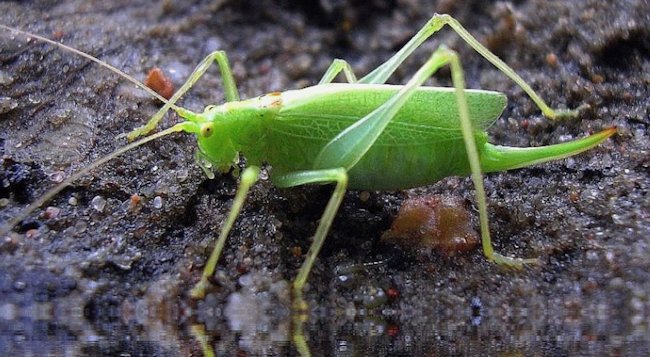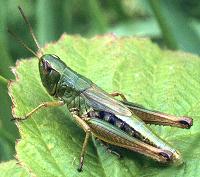H9. The Light Green Hopper

![]()
![]()
![]()
![]()
![]()
![]()
![]()
![]()
![]()
GRASS HOPPER AND CRICKET FLY PATTERNS. Hook size 12 - $US each
 Trout do not care if their food rises up from the
stream bottom to hatch, or if it falls in from above. Trout pay close attention
to the surface and this makes terrestrials an important food source. Anglers
should not neglect flies that imitate terrestrial insects. Terrestrials can make
up more than 80% of a fish's diet at certain times of the year--especially in
late summer and early fall. Grasshoppers survive well after the first frosts,
although they are less vigorous, and hence more vulnerable. The will continue to
catch fish in most places well into October. ( Terrestrial insects are any fish food that has no
aquatic stage like grasshoppers, ants, crickets, beetles, leafhoppers,
caterpillars, inch worms, spiders, snails) At certain time of year grasshoppers become abundant. If you are in luck, a wind will blow these wonderful fish snacks into your favorite
waters. It is then a great time to be a fly fisherman. A delicate presentation
is not critical then because even big selective trout (largemouth or smallmouth
bass, bluegill, etc.) are looking for the tell-tale splat of this helpless
terrestrial as it flops into their eating zone. Second, these are big flies and
you can use short leaders that are easy to cast. Moreover, even if a hopper has
been chewed on a few times, the fish don't seem to mind. Grasshoppers can swim
by kicking their hind legs in unison, using the same method as they employ when
jumping. This is simply mimicked by fishing the fly on the surface and
retrieving it with short sharp pulls. Continue for about three feet and then let
your fly drift for 20 seconds before recommencing the retrieve. This imitates
the grasshopper having a rest. Hoppers generally hatch from eggs in June and
July and are full grown by mid-August. The adults continue to feed until the
first frost. The eggs are laid under ground in late September and October. The
best hopper fishing occurs in August and early September. They like hot weather,
and you will find your best hopper fishing on hot windy afternoons. The only
downside with hopper patterns is that they don't work all year round but keep
some in your fly box just in case. Trout move into shallower riffles downwind
from riverbanks near hayfields as the day warms up, on the lookout for helpless
struggling grasshoppers locust and crickets. Earlier in the day these fish will
be hold up in deeper water, along seams. banks and drop offs. Once it gets
warmer they return to the areas where they have feasted on these unlucky insects
in the past.
Trout do not care if their food rises up from the
stream bottom to hatch, or if it falls in from above. Trout pay close attention
to the surface and this makes terrestrials an important food source. Anglers
should not neglect flies that imitate terrestrial insects. Terrestrials can make
up more than 80% of a fish's diet at certain times of the year--especially in
late summer and early fall. Grasshoppers survive well after the first frosts,
although they are less vigorous, and hence more vulnerable. The will continue to
catch fish in most places well into October. ( Terrestrial insects are any fish food that has no
aquatic stage like grasshoppers, ants, crickets, beetles, leafhoppers,
caterpillars, inch worms, spiders, snails) At certain time of year grasshoppers become abundant. If you are in luck, a wind will blow these wonderful fish snacks into your favorite
waters. It is then a great time to be a fly fisherman. A delicate presentation
is not critical then because even big selective trout (largemouth or smallmouth
bass, bluegill, etc.) are looking for the tell-tale splat of this helpless
terrestrial as it flops into their eating zone. Second, these are big flies and
you can use short leaders that are easy to cast. Moreover, even if a hopper has
been chewed on a few times, the fish don't seem to mind. Grasshoppers can swim
by kicking their hind legs in unison, using the same method as they employ when
jumping. This is simply mimicked by fishing the fly on the surface and
retrieving it with short sharp pulls. Continue for about three feet and then let
your fly drift for 20 seconds before recommencing the retrieve. This imitates
the grasshopper having a rest. Hoppers generally hatch from eggs in June and
July and are full grown by mid-August. The adults continue to feed until the
first frost. The eggs are laid under ground in late September and October. The
best hopper fishing occurs in August and early September. They like hot weather,
and you will find your best hopper fishing on hot windy afternoons. The only
downside with hopper patterns is that they don't work all year round but keep
some in your fly box just in case. Trout move into shallower riffles downwind
from riverbanks near hayfields as the day warms up, on the lookout for helpless
struggling grasshoppers locust and crickets. Earlier in the day these fish will
be hold up in deeper water, along seams. banks and drop offs. Once it gets
warmer they return to the areas where they have feasted on these unlucky insects
in the past.
Banks are the key to successfully fishing Hoppers. Most grasshoppers that find their way into the water's surface are concentrated in the foliage along the banks. Banks also provide cover and shade for fish during hot summer afternoons. Thus fish, which move to the banks for cover and shade, are putting themselves in the exact place where grasshoppers are most available. On large rivers, grasshoppers should be cast as close to the banks as possible. This is more important in streams where banks are slightly undercut and where vegetation hangs out over the water. On small streams, trout often see grasshoppers all across the water and will be willing to take an imitation in the middle of the stream. I was fishing on a small river in the French Alps last summer. There were fields either side of the river but the banks were wooded. I was surrounded by breath taking views of snow covered mountains. The sun was out and it was a perfect day. The early morning hatch had finished and takes were getting harder and harder as the fish started to hide from the midday sun. I noticed some light green grass hoppers jumping from rock to rock. Some missed and floated in the water, struggling against the current. Then there was a sudden splash. A trout had struck and successfully gained a large nourishing meal. One of these struggling creatures passed near my boot. I scooped it up from the water and put him on the bank where he could dry. This idiotic insect, with a death wish, jumped straight back into the river instead of the relative safety of the woods and fields. I observed that trout would move from their midday resting place to attack a grass hopper floating in the surface film where as they would not move for a standard mayfly pattern. Trout know that grass hoppers are a very substantial meal compared with a mayfly and therefore consider them worth the effort and energy of an attack.

![]()
![]()
![]()
![]()
![]()
![]()
![]()
![]()
![]()
FISHING MOUNTAIN LAKES
 The secret to understanding Summer fishing in mountain lakes is to remember
that the wind blows up hill. What is he talking about I hear you saying to
yourself. What on earth has that got to do with fishing? It has everything to do
with Mountain Fishing. Terrestrial insects like grass hoppers, beetles and ants
make up 80% of the summer diet of trout and grayling in alpine mountainous environments.
They are carried up the mountain by the wind and deposited in the high altitude
lakes. (the biologists call them 'upslope blow-ins') Combine this with with the
amount of emergent or adult forms of aquatic insect life taken in the surface
film then you find that 90% of their food comes from the top. The mountain lake
trout cruise and search for food on the water surface film and this is where you
should be fishing.
The secret to understanding Summer fishing in mountain lakes is to remember
that the wind blows up hill. What is he talking about I hear you saying to
yourself. What on earth has that got to do with fishing? It has everything to do
with Mountain Fishing. Terrestrial insects like grass hoppers, beetles and ants
make up 80% of the summer diet of trout and grayling in alpine mountainous environments.
They are carried up the mountain by the wind and deposited in the high altitude
lakes. (the biologists call them 'upslope blow-ins') Combine this with with the
amount of emergent or adult forms of aquatic insect life taken in the surface
film then you find that 90% of their food comes from the top. The mountain lake
trout cruise and search for food on the water surface film and this is where you
should be fishing.
The upslope winds occur when the high ridges receive the morning sun whilst the valleys are still in shade. The cool air of the valley bottom is sucked up to the ridges as the layers mix in an effort to equalize the air temperature. The greater the temperature disparity the stronger the winds. Bug falls are greater in the afternoon. The lake is a heat sink as it is cooler than the surrounding land and therefore creates a thermal variation and downdraft. Ants are easily plucked from the surface by the winds even by mild winds. They are often the most numerous insect dropped on the water surface because of their low weight. Production of single cell organisms are low and rooted plants are sometimes absent due to the low average temperature . Two winged diptera midge flies are the most common aquatic insects. There are no major hatches of Caddis, Damselflies or Mayflies on many of these lakes. If it has rained within the last 24 hours runoff from a rainstorm will bring drowned spiders, bees, worms and insects into the lake. A Timberwolf, black soft hackle spider or San Juan Worm will bring results fished dead drift. On windless days flying insects still blunder their way onto the water. Just leave a pan of water out for a day and you will find moths, flies and bees floating in the surface. Last year when fishing high up in the Swiss Alps I noticed that the most common colour alpine grasshopper were light green or a grey and brown colour. I caught fish on Dave's hopper, the light green Hopper and the grey hopper. These stupid insects live around the lake edges and when they hop a gust of wind takes them off course and plop they are fish food.

![]()
![]()
![]()
![]()
![]()
![]()
![]()
![]()
![]()
To be sent regular fly fishing information and news on special offers click the British Royal Mail Post box
You can e-mail us at fly.fishing@blueyonder.co.uk
The English Fly Fishing Shop, Estate and Country Sports
Equipment Ltd,
5 Woodland Way, Morden, Surrey SM4 4DS, England (Established
1978)